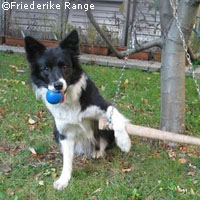Research reveals dogs to be copycats
EU-funded researchers have shown for the first time that animals are able to imitate selectively. The scientists demonstrated that dogs are not only able to imitate other dogs, they decide whether or not to imitate based on circumstances. The work, which was funded through the Sixth Framework Programme (FP6) project EDICI (Evolution, Development and Intentional Control of Imitation), is published online by the journal Current Biology. In the experiment, food was placed in a container which the dogs could not reach directly; to get the food, the dogs had to pull down a wooden rod. The easiest way for the dogs to manipulate this rod was with their mouths, and when presented with the system without being shown how it worked, most dogs automatically used their mouths to pull down the food and get the treat. Central to the experiment was a two-year old Border Collie called Guinness, who belongs to lead researcher Friederike Range of the University of Vienna. Guinness had been trained by the researchers to manipulate the rod with her paw, instead of her nose. In one experiment, 19 test dogs watched as Guinness used her paw to pull down the rod and obtain the food. 'When it was the turn of the test dogs, we were totally amazed,' said Dr Range. 'The majority of the test dogs didn't use their mouth, but their paw, just as Guinness had shown them. Without the demonstration they would certainly have chosen the more effective method with their mouths.' In a second experiment, 21 dogs watched as Guinness used her paw to pull down the rod. However, this time, she also had a ball in her mouth. When it was the test dogs' turn, most of them used their mouths to operate the rod. 'Here we set up a situation in which it seems completely logical for Guinness to use her paw, because she doesn't want to drop the ball,' explained Dr Range. In other words, when the dogs could see why Guinness was using her paw and not her mouth (i.e. she had a ball in her mouth), they chose the easier method of pulling down on the rod. However, when Guinness did not have a ball in her mouth, the dogs assumed that there must have been another reason for her to use her paw, and so the dogs copied her. 'With our experiment we could show for the first time that dogs are able to imitate other dogs,' said Dr Range. Previous studies have shown that young children also have the ability to imitate selectively. The next challenge for the researchers is to determine whether other animals share this ability, and if it is restricted to dogs, whether it is the result of their evolutionary history of domestication or their developmental training by humans.
Countries
Austria, Hungary



